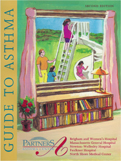Guide to Asthma
Practice Session #5: "A Walk in the Park"
Just yesterday you had commented to a friend how well your asthma seemed to be doing lately. You were taking your preventer medication in the form of a tablet every day and rarely needed to use your quick-relief bronchodilator. People at work no longer recognized you by your ever-present cough. Even your sleeping had become more restful, no longer interrupted by coughing and a sense of chest tightness.
Today, at the insistence of family and friends, you have agreed to participate in a local July 4th walk-run family race. It is a hot and muggy summer day, and your breathing does not feel its best even when you are sitting quietly. When your turn comes, you go at it hard for 15 minutes, until your legs feel like rubber. Your breathing becomes labored and you start to cough repetitively. You find the nearest bench and plop onto it "like a wet dish rag."
You search deep in all your pockets for your quick-relief bronchodilator. When your asthma was under poor control, you could not have imagined going anywhere without it. You always carried one with you, besides keeping one in your car, one at your office, and one by the bedside table at night. Now, to your dismay, you find that you have come out without bringing it with you.
As you feel your strength coming back to your arms and legs and your breathing slowing somewhat, you consider what to do next.
What would you do?
Discussion:
Exercise has the potential to trigger symptoms in virtually everyone with asthma. Exercise causes us to breathe heavily, and as we do, we bring extra amounts of air down into our lungs and onto our bronchial tubes. Especially if the air that we breathe during exercise is cold and dry, or filled with air pollutants, fumes, or other irritating substances, exercise can cause the muscles surrounding the bronchial tubes to contract and the airways to narrow.
The good news, however, is that an attack of asthma brought on by exercise is generally short-lived. The bronchial muscles usually begin to relax over a period of minutes and your breathing tends to return to normal over about 30-60 minutes. Also, there is much less inflammation and swelling of the bronchial tubes caused by exercise than by allergic triggers, such as cat danders or dust mites. Unless you are allergic to pollen and ran your race on a day with a high pollen count, there is a good chance that your breathing will continue to improve as you sit quietly and relax.
Staying calm is a good strategy for any asthmatic attack. Breathe slowly and deeply, and with each breath give adequate time for breathing out. Try counting three beats out for every one beat spent breathing in.
If your breathing remains difficult despite resting, you may decide to borrow a quick-relief bronchodilator inhaler from a friend or family member. Asthma is common and there is a good chance that you will find someone nearby willing to help. At the same time, it is a good rule never to use a medication with which you are unfamiliar. If there is any doubt that the offered medication is appropriate and safe for you, it is best to decline its use. If you find yourself gradually getting better, you would do best to wait until you return home and retrieve your own medicine.
What could you have done preventively?
You make a mental list of the things that you could have done differently so that this attack might have been prevented. Most importantly, you vow always to bring a quick-relief bronchodilator inhaler with you, even when your asthma is under good control. You also remember that using the quick-relief bronchodilator about 5-10 minutes before exercising is an effective strategy for preventing the bronchial muscle contraction brought on by exercise.
Other strategies do not require any medication. For one thing, you might have declined to participate in the race on a day when your breathing did not feel fully comfortable. Abstinence was one option! Also, many athletes with exercise-induced asthma find that a brief warm-up period before exercising (for example, light walking or jogging in place) and a brief cool-down period after exercising can help to minimize the effect of exercise on their breathing.
On a cold, winter’s day (not July 4th!), it is helpful if you can avoid breathing cold air during exercise. You may decide to exercise indoors, or you can try wearing a thick scarf over your nose and mouth. With the scarf, you can trap in front of your face some of the warm, moist air that you exhale. A cold weather face mask is sold for the same purpose.

